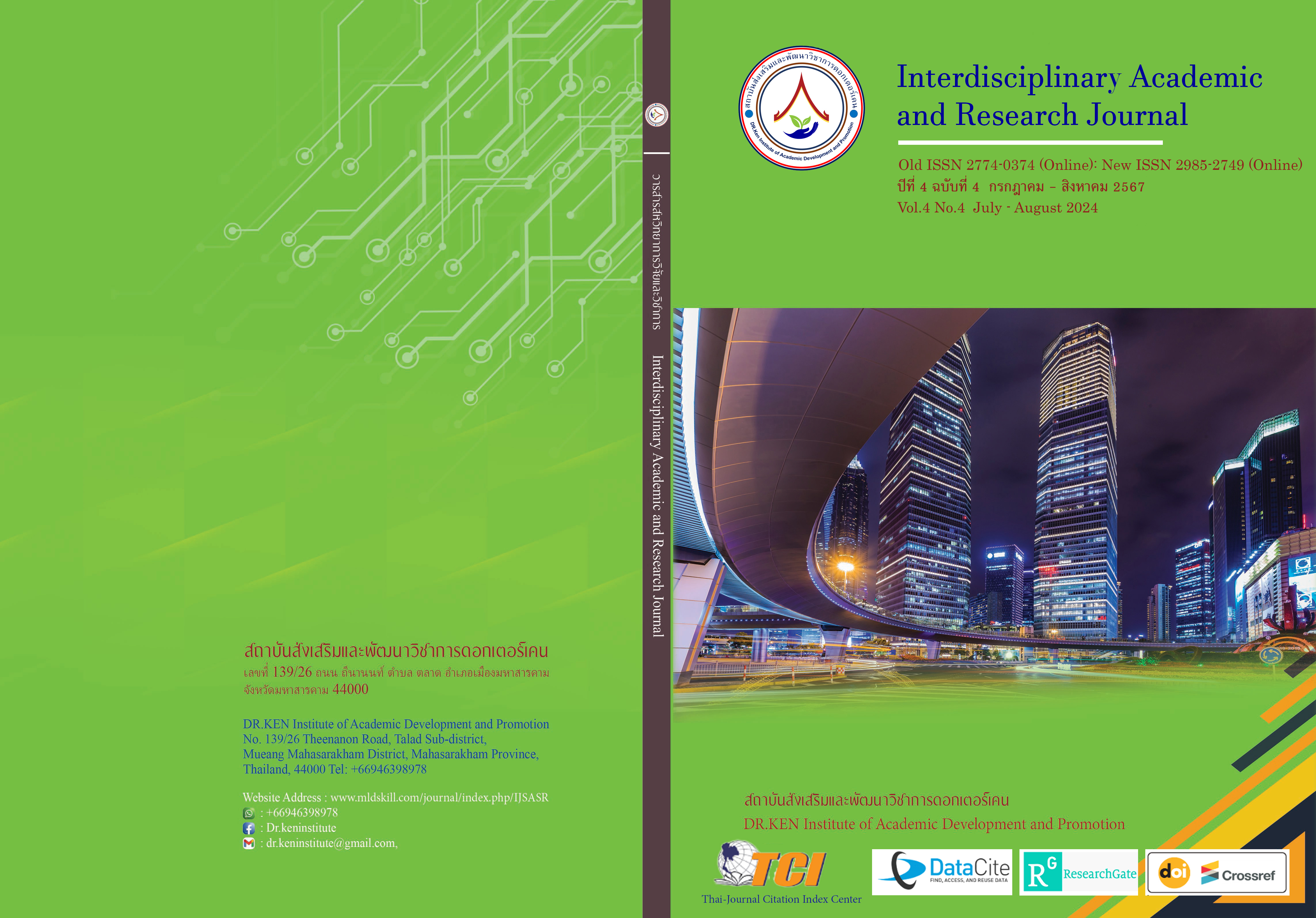Development of Mathematics Teaching Models According to the Theory of Knowledge Creation to Promote the Mathematical Competence of Mathayom 6 Student
DOI:
https://doi.org/10.60027/iarj.2024.276476Keywords:
Mathematics Teaching Formats; , Theory of Knowledge Creation;, Mathematics PerformanceAbstract
Background and Aims: The development of human thought is greatly aided by mathematics, which fosters creativity, and logical and systematic thought, benefits life, and raises the standard of living. (1) the first goal of this research is to create a mathematical teaching model for Mathayom 6 students that is based on the theory of knowledge creation. And (2) Examine the effects of utilizing a theory of knowledge creation-based mathematics teaching model to enhance Mathayom 6 students' mathematical proficiency.
Methodology: Three research steps make up this study. (1) Phase 1: Basic information, current conditions, and conditions for teaching mathematics are studied, along with concepts, theories, and research about models of teaching mathematics based on knowledge creation theory to enhance secondary school students' mathematical competency. Year 6 by speaking with five education specialists. (2) Phase 2: Creating a teaching model for mathematics based on the theory of knowledge creation to help students in Mathematical Competency 6 and (3) Phase 3: Testing out a model of teaching mathematics based on the theory of knowledge creation to improve Mathayom 6 students' performance in the subject. Thirty Mathayom 6 students from Thesaban 2 School in Nangrong Municipality, Nangrong District, Buriram Province participated in the model's testing as a sample group during the second semester of the academic year 2022; (1) A mathematics teaching model based on the theory of knowledge creation to support Mathayom 6 students' mathematical competency is one of the instruments used to gather data. (2) Learning Satisfaction Scale; (3) Mathematics Competency Test; and (2) Achievement Test, the t-test (Dependent), mean, percentage, and standard deviation are among the statistics used in data analysis.
Results: (1) A mathematical competency-promoting teaching model for Mathayom 6 students, based on the theory of knowledge creation. There are six parts. These include the model's goals, instructional strategies, social systems, response theories, and support networks. Four steps make up the teaching process: (1.1) Step of operation (Operation: O) (1.2) Step two: Action (Acting: A) (1.3) Step three: Knowledge creation (Creation: C), additionally, (1.4) Recapitulating the idea (Idea: C) and a high degree of appropriateness was indicated by the model's evaluation results, which had a mean of 4.47 and a standard deviation of 0.41. (2) The application of the theory of knowledge creation to the mathematics teaching model revealed that at a statistical significance of.05., students' academic achievement is higher than it was before they started studying. When Mathayom 6 students use the mathematics teaching model, their performance in mathematics exceeds the 70% threshold. Additionally, a high degree of student satisfaction has been observed with the mathematics teaching model.
Conclusion: To emphasize mathematical competency, the study presents a comprehensive teaching model for Mathayom 6 students that is based on the theory of knowledge creation. The effectiveness of the model is demonstrated by the evaluation results, which show a significant improvement in academic achievement and student satisfaction, both of which exceed the performance threshold of 70%.
References
กระทรวงศึกษาธิการ. (2552). หลักสูตรแกนกลางการศึกษาขั้นพื้นฐานพุทธศักราช 2551. กรุงเทพฯ : โรงพิมพ์ชุมนุมสหกรณ์การเกษตรแห่งประเทศไทย จำกัด.
ทิศนา แขมมณี. (2558). ศาสตร์การสอน : องค์ความรูเพื่อการจัดกระบวนการเรียนรูที่มีประสิทธิภาพ. พิมพ์ครั้งที่ 19. กรุงเทพฯ : ด่านสุทธาการพิมพ์.
นงค์เยาว์ นามไธสง. (2560). การพัฒนากิจกรรมการเรียนรู้คณิตศาสตร์แบบสืบเสาะหาความรู้ 5E ที่ส่งเสริมความสามารถในการให้เหตุผลทางคณิตศาสตร์ เรื่อง เส้นขนาน ชั้นมัธยมศึกษาปีที่ 2. วิทยานิพนธ์ปริญญามหาบัณฑิต มหาวิทยาลัยมหาสารคาม.
ประสาท เนืองเฉลิม. (2556). วิจัยการเรียนการสอน. พิมพ์ครั้งที่ 2. กรุงเทพฯ : สำนักพิมพ์แห่งจุฬาลงกรณ์มหาวิทยาลัย.
ปัทมาสน์ งามอนันต์. (2563). การพัฒนากิจกรรมการเรียนรู้คณิตศาสตร์โดยใช้เกมมิฟิเคชันเพื่อเสริมสร้างแรงจูงใจและมโนทัศน์ทางคณิตศาสตร์ สำหรับนักเรียนชั้นประถมศึกษาปีที่ 3. ศึกษาค้นคว้าอิสระการศึกษามหาบัณฑิต สาขาหลักสูตรและการสอน, มหาวิทยาลัยนเรศวร.
เพชรชนก จันทร์หอม. (2562). การพัฒนามโนทัศน์ทางคณิตศาสตร์ด้วยกิจกรรมการเรียนรู้ตามแนวคิด Concrete-Pictorial-Abstract (C-P-A) เรื่อง รูปเรขาคณิตสองมิติและสามมิติของนักเรียนชั้นมัธยมศึกษาปีที่ 1. วิทยานิพนธ์การศึกษามหาบัณฑิต มหาวิทยาลัยนเรศวร.
วิจารณ์ พานิช. (2556). การเรียนรู้เกิดขึ้นได้อย่างไร. กรุงเทพฯ:บริษัท เอส อาร์.พริ้นติ้ง.
วีณา ประชากูล และประสาท เนืองเฉลิม. (2559). รูปแบบการเรียนการสอน. พิมพ์ครั้งที่ 3. มหาสารคาม :มหาวิทยาลัยมหาสารคาม.
สถาบันส่งเสริมการสอนวิทยาศาสตร์และเทคโนโลยี. (2555). ครูคณิตศาสตร์มืออาชีพเส้นทางสู่ความสำเร็จ. กรุงเทพฯ : 3–คิวมีเดีย.
สมบัติ ท้ายเรือคำ (2551). วิธีการทางสถิติสาหรับการวิจัย. มหาสารคาม: ภาควิชาวัดผลและวิจัยการศึกษา, คณะศึกษาศาสตร์ มหาวิทยาลัยมหาสารคาม
สิทธิชัย ชมพูพาทย์. (2554). การพัฒนาพฤติกรรมการเรียนการสอนเพื่อแก้ปัญหาอย่างสร้างสรรค์ของครู และนักเรียนในโรงเรียนส่งเสริมนักเรียนที่มีความสามารถทางวิทยาศาสตร์โดยใช้การวิจัย ปฏิบัติการเชิงวิพากษ์. วิทยานิพนธ์ปรัชญาดุษฎีบัณฑิต : มหาวิทยาลัยศรีนครินทรวิโรฒ.
สุนทรีย์ ปาลวัฒน์ชัย. (2559). การพัฒนารูปแบบการจดัการเรียนรู้ตามแนวทฤษฎีการสร้างความรู้เพื่อส่งเสริมสมรรถภาพทางทันตศาสตร์ของนักเรียนชั้นมัธยมศึกษาปี ที่ 1. ดุษฎีนิพนธ์ปริญญาศึกษาดุษฎีบัณฑิต สาขาวิชาหลักสูตรและการสอน คณะศึกษาศาสตร์ มหาวิทยาลัยบูรพา. ชลบุรี.
อัครพล พรมตรุษ. (2565). การพัฒนาความเข้าใจมโนทัศน์ทางคณิตศาสตร์ของนักเรียนชั้นมัธยมศึกษาปีที่ 1 โดยใช้วิธีแบบเปิด : การวิจัยเชิงปฏิบัติการในชั้นเรียน. วารสารศึกษาศาสตร์สาร มหาวิทยาลัยเชียงใหม่, 6(2), 61-75.
Johnson, D.W., Johnson, R.T., & Smith, K.A. (2014). Cooperative learning: Improving university instruction by basing practice on validated theory. Journal on Excellence in College Teaching, 25(4), 85-118.
Treffinger, D.J., Isaksen, S.G., & Dorvol, K.B. (2008). Creative Problem Solving (CPS Version 6.1TM) A Contemporary Framework for Managing Change. Sarasota: Center for Creative Learning and Creative Problem Solving Group.
Downloads
Published
How to Cite
Issue
Section
License
Copyright (c) 2024 Interdisciplinary Academic and Research Journal

This work is licensed under a Creative Commons Attribution-NonCommercial-NoDerivatives 4.0 International License.
Copyright on any article in the Interdisciplinary Academic and Research Journal is retained by the author(s) under the under the Creative Commons Attribution-NonCommercial-NoDerivatives 4.0 International License. Permission to use text, content, images, etc. of publication. Any user to read, download, copy, distribute, print, search, or link to the full texts of articles, crawl them for indexing, pass them as data to software, or use them for any other lawful purpose. But do not use it for commercial use or with the intent to benefit any business.
















.png)


